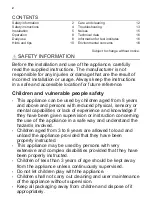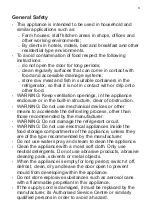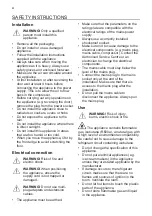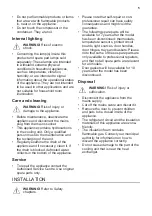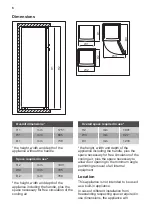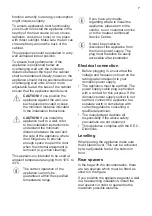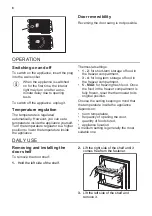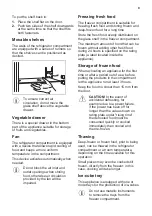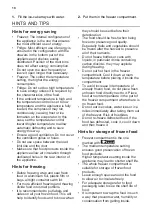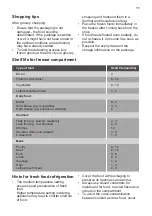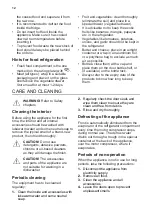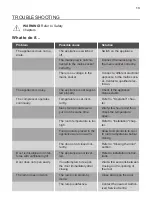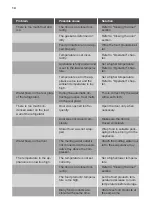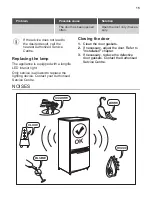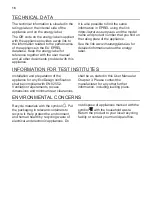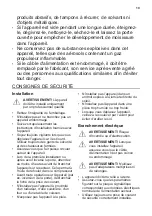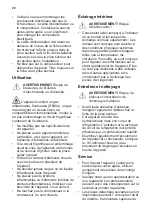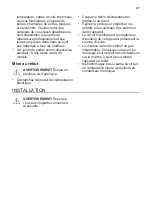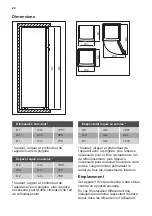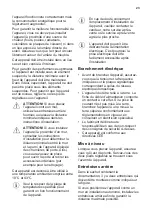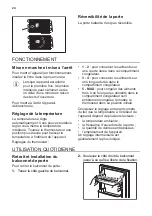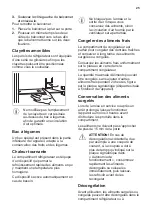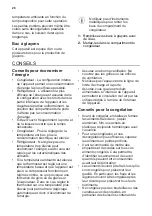
the cooked food and separate it from
the raw one.
• It is recommended to defrost the food
inside the fridge.
• Do not insert hot food inside the
appliance. Make sure it has cooled
down at room temperature before
inserting it.
• To prevent food waste the new stock of
food should always be placed behind
the old one.
Hints for food refrigeration
• Fresh food compartment is the one
marked (on the rating plate) with
.
• Meat (all types): wrap in a suitable
packaging and place it on the glass
shelf above the vegetable drawer.
Store meat for at most 1-2 days.
• Fruit and vegetables: clean thoroughly
(eliminate the soil) and place in a
special drawer (vegetable drawer).
• It is advisable not to keep the exotic
fruits like bananas, mangos, papayas
etc. in the refrigerator.
• Vegetables like tomatoes, potatoes,
onions, and garlic should not be kept in
the refrigerator.
• Butter and cheese: place in an airtight
container or wrap in an aluminium foil
or a polythene bag to exclude as much
air as possible.
• Bottles: close them with a cap and
place them on the door bottle shelf, or
(if available) on the bottle rack.
• Always refer to the expiry date of the
products to know how long to keep
them.
CARE AND CLEANING
WARNING! Refer to Safety
chapters.
Cleaning the interior
Before using the appliance for the first
time, the interior and all internal
accessories should be washed with
lukewarm water and some neutral soap to
remove the typical smell of a brand-new
product, then dried thoroughly.
CAUTION! Do not use
detergents, abrasive powders,
chlorine or oil-based cleaners
as they will damage the finish.
CAUTION! The accessories
and parts of the appliance are
not suitable for washing in a
dishwasher.
Periodic cleaning
The equipment has to be cleaned
regularly:
1. Clean the inside and accessories with
lukewarm water and some neutral
soap.
2. Regularly check the door seals and
wipe them clean to ensure they are
clean and free from debris.
3. Rinse and dry thoroughly.
Defrosting of the appliance
Frost is automatically eliminated from the
evaporator of the refrigerator compartment
every time the motor compressor stops,
during normal use. The defrost water
drains out through a trough into a special
container at the back of the appliance,
over the motor compressor, where it
evaporates.
Periods of non-operation
When the appliance is not in use for long
periods, take the following precautions:
1. Disconnect the appliance from
electricity supply.
2. Remove all food.
3. Clean the appliance and all
accessories.
4. Leave the doors open to prevent
unpleasant smells.
12


